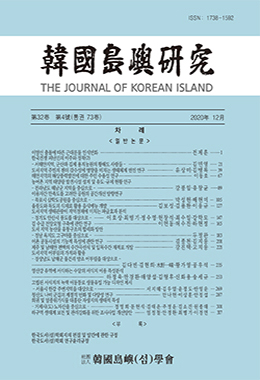본 연구는 우리나라 남해안 일대 분포하는 어부림 중 가장 잘 알려진 남해군 물건리 방조어부림을 대상으로 자연 및 인문학적 가치평가와 지역 발전을 위한 공간 자원으로써의 활용 가능성을 모색해보고자 한다. 어부림(魚付林)이란 우리나라 남해안 일대 분포하는 전통 마을 숲의 하나로 방풍(防風), 방조(防潮), 방파(防波), 어군(漁群) 등의 기능을 한다. 바다로부터 해안마을을 보호할 뿐만 아니라 마늘의 안녕을 기원하는 신앙의 공간이며, 휴식의 공간이기도 하다. 더불어 건강하고 오래된 숲은 자연생태학적 가치도 적지 않다. 하지만 아직 어부림에 대한 정확한 정의와 구조, 형태, 기능 등에 대해 그 구분이 명확하지 않아 많은 어부림이 상록수림, 방풍림 등으로 명명되어 있다. 특히 남해군 삼동면 물건리 방조어부림은 우리나라에서 가장많이 알려진 곳으로 다양한 연구들이 수행되었으나 물건리 방조어부림의 공간 가치 및 활용방안에 대한 종합적인 연구는 아직 부족한 실정이다.
구조적으로 살펴본 결과 물건리 방조어부림은 남해군 본섬 동쪽 만에 남북방향으로 긴 띠형태를 이루고 있으며 길이는 약 1.5㎞, 면적은 약 23,438㎡이다. 물건리 방조어부림은 자연 지형이 전혀 없는 물건리 동쪽 바다에서 불어오는 바람과 태풍 등 자연재해의 위험으로부터 마을을 보호하는 역할을 한다. 인문학적 관점에서 물건리 방조어부림은 마을의 안녕과 풍년·풍어를 기원하던 신앙적인 공간이었으며, 더불어 마을 주민들의 휴식 공간으로 물건리 주민들과 항상 같이했던 친근한 곳으로써 의미가 있었다. 또한 물건리 방조어부림에는 높이 10m 이상의 느티나무(Zelkova serrata), 푸조나무(Aphananthe aspera), 이팝나무(Chionanthus retusus), 말채나무(Cornus walteri) 등의 교목들이 자생하며 건강하고 독립된 생태 숲을 이루고 있다. 하지만 체계적인 관리가 없고, 일부 귀화식물 및 생태계 교란 식물의 분포도 확인되어 이에 대한 관리가 요구된다.
물건리 방조어부림의 활용 가능성을 알아보고자 설문조사를 실시한 결과 물건리 방조어부림에 대한 재방문 및 추천 의사가 100명 중 90명이 넘을 정도로 긍정적이었다. 이러한 결과는 마을 단위에서 물건리 방조어부림을 활용한 마을 발전 가능성이 충분하다는 것을 보여주는 결과로 볼 수 있다. 결론적으로 긴 역사를 간직하고 있는 물건리 방조어부림은 자연과 역사 그리고 문화가 혼재하는 함축된 장소로 보존하고 가꾸어야 할 공간으로써 그 가치와 활용 가능성이 크다고 볼 수 있다.
This study, which examines the windbreaks and fish shelter forest in Mulgeonri, Namhaegun, a popular fish shelter forest on the southern coast of Korea, aims to assess its natural and humanistic value and explore its potential utility as a spatial resource for regional development. The fish shelter forest is a traditional village forest that is found on the southern coast of Korea and serves as a windbreak, a breakwater that stops tides and waves, and a fishing bank. It not only protects coastal villages from the sea, but also serves as a resting place and a place of faith where people offer prayers and make wishes. Moreover, old and healthy forests possess significant ecological value. However, as the definition, structure, form, and function of fish shelter forests have yet to be clearly distinguished, many of them are termed as evergreen forests, windbreak forests, etc. In particular, the windbreak and fish shelter forest in Mulgeonri, Samdongmyeon, Namhaegun is the most popular forest of this type in Korea and it has been extensively studied. However, insufficient research exists regarding its spatial value and its possible utility as a resource for regional development. The forest in Mulgeonri, which forms a long strip from the south to the north on the inlet located east of the main island of Namhaegun, is about 1.5 ㎞ long and has an area of approximately 23,438㎡. The forest protects the village from natural hazards such as winds and typhoons that blow from the sea to the east of Mulgeonri. The forest also holds significant value for humans, because it serves both as a spiritual place where residents have wished for peace and good harvests and as a resting place that the residents consider familiar and comfortable. Additionally, the forest is a healthy, independent ecological forest with autochthonous trees that stand 10m tall or more, such as Zelkova serrata, Aphananthe aspera, Chionanthus retusus, and Cornus walteri. However, since there is no organized management of the forest, the presence of some naturalized plants and invasive species has been observed, and measures need to be taken to manage its condition.
This survey, which inquired into the possible uses of the forest in Mulgeonri, returned positive findings. Over 90 out of the 100 respondents were willing to return to the forest and to recommend it. The results suggest that the village has a good chance of facilitating its own development by tapping into the resources provided by the forest. In conclusion, the windbreak and fish shelter forest in Mulgeonri has great value and utility as a space that serves as an amalgamation of nature, history, and culture. It should therefore be preserved and tended to in the manner that befits such a unique natural treasure.




